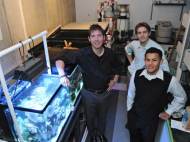Harlequin mantis shrimp club structure inspires new armor
 Researchers at the University of California, Riverside’s Bourns College of Engineering, have been investigating the harlequin mantis shrimp– a marine crustacean notorious for its club-like arm which is capable to create great forces for its size. Instead focusing on the great speed and power of the club, the group focused their research on its unique structure which allows it to withstand these forces.
Researchers at the University of California, Riverside’s Bourns College of Engineering, have been investigating the harlequin mantis shrimp– a marine crustacean notorious for its club-like arm which is capable to create great forces for its size. Instead focusing on the great speed and power of the club, the group focused their research on its unique structure which allows it to withstand these forces.
The fist-like club of the harlequin mantis shrimp (Odontodactylus scyllarus) accelerates underwater faster than a 22-caliber bullet. The acceleration of the club shears the water, literally boiling it, and creates cavitation bubbles that implode, thus creating a secondary impact on its prey. The force created by the mantis shrimp’s impact is more than 1,000 times its own weight. During the tests, it needs to be kept in a special aquarium because it creates enough power to break the glass.
Led by David Kisailus, an assistant professor at the Bourns College of Engineering, the multidisciplinary team of researchers from various universities focused on research of the material the fist-like club is made of and they found that the club comprised of three specialized regions that work together to create a structure tougher than many engineered ceramics.
The first region, located at the impacting surface of the club, contains a high concentration of a mineral which supports the impact when the mantis shrimp strikes prey. Second region acts as a shock absorber which consists out of highly organized and rotated layers of chitin fibers dispersed in mineral. The last region Finally, the club is encapsulated on its sides by oriented chitin fibers, which wrap around the club, keeping it intact during these high velocity impacts.
Their next step is to continue their research in order to find more information about the structure of the harlequin mantis shrimp’s club in order to design materials inspired by that structure. Kisailus said the potential applications in structural materials are widespread because the final product could be lighter weight and more impact resistant than currently available products.
Since military body armor weights around 13.6 kg (30 pounds), Kisailus sees this as an opportunity to develop a material that is one-third the weight and thickness of existing body armor. This light and strong material could find its use in electric cars where it could lower their weight, or in airplanes where it could do the same with additional impact resistance which would improve reliability and lower maintenance expenses.
For more information, read the paper published in the journal Science: “The Stomatopod Dactyl Club: A Formidable Damage-Tolerant Biological Hammer”.









Leave your response!